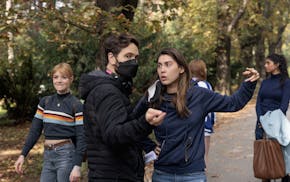Federal health officials recently expanded their masking recommendations beyond public indoor spaces to include crowded outdoor settings in areas where COVID-19 transmission levels are high.
In Minnesota, that includes most areas of the state, including Ramsey County, home of the Minnesota State Fair.
While fair officials had already recommended face coverings in outside crowds, the new guidance underscores the increasing risk of transmission in settings that were once considered to be safer.
"This of course is yet another indication that the highly infectious delta variant is changing the game," state infectious disease director Kris Ehresmann said. "We aren't going to wish away this virus, and delta is particularly good at finding you if you let down your guard."
The outdoor masking recommendation is another response by health officials to control the delta variant, which is causing serious illness in the unvaccinated but also can infect those who are fully vaccinated, who typically develop less severe illness.
But the recommendations ask for voluntary compliance because most states have ended public health emergencies that enable mandates. Minnesota's ended in late June, just as the delta variant was taking hold.
Oregon issued an outdoor mask mandate on Tuesday, two weeks after imposing an indoor mandate. In Minnesota, private businesses can set their own mandates for employees and visitors to their buildings.
New COVID-19 cases have been traced to recent outdoor events by Minnesota health officials.
Nine cases, including a 38-year-old who was hospitalized, have been traced to the WE Fest country music festival that took place without COVID-19 restrictions in Detroit Lakes three weeks ago.
The recent Sturgis Motorcycle Rally so far has been linked to 13 infections in Minnesotans.
"We are seeing transmission in crowded outdoor settings," Ehresmann said. "With delta, when we have large groups of people together that can be problematic. That is why CDC is responding to what we are learning with this change and recommending masking in crowded outdoor settings."
People infected by delta carry a higher level of infectious virus in their bodies, meaning that it is much easier to spread to others compared with the original virus and some earlier strains.
CDC officials originally estimated it would require 15 minutes of exposure to an infected person for transmission to occur. That can happen a lot faster with the delta variant, but federal health officials have not commented about a shorter exposure time.
"CDC had not officially changed their guidance," Ehresmann said. "I think it is fair to say because of [the higher viral loads] it is likely that less time would be necessary to become exposed to someone."
The delta COVID-19 variant has become the dominant strain in Minnesota and nationwide and quickly fueled a surge of cases.
Although Minnesota is still below the big wave of cases late last year and another one that peaked in April, case growth is 84% higher than last August.
The state's per capita case growth rate is 22.8%, while the testing positivity rate has reached 6%, the highest number since early May.
On Tuesday, the Minnesota Department of Health announced 3,838 new COVID-19 confirmed cases. Because the health agency no longer releases COVID-19 data on the weekends, the Tuesday number represents three days of case reports for an average of about 1,280 cases per day.
Another eight deaths were reported, including two people younger than 50.
The pandemic has taken the lives of 7,775 Minnesotans and infected at least 639,059.
More Minnesotans are spitting into tubes or enduring nasal swabs to see if they are infected.
The daily average of test reports arriving at the Health Department is nearly 26,000 compared with a recent low of about 9,100 tests in early July.
Testing is up 62% compared with one year ago, Health Commissioner Jan Malcolm said.
The recent surge in cases has led to more COVID-19 hospitalizations, which public health officials consider to be in high-risk territory.
As of Monday there were 547 COVID-19 patients in the state's hospitals, a one-day increase of 27. Of those, 153 needed intensive care due to COVID-19 complications, up eight from the previous day.
COVID-19 is just one factor that is putting stress on the state's hospital system, with 92% of all staffed ICU beds occupied.
"Summer is always a busy season in Minnesota's hospitals," Malcolm said, noting that trauma cases are more prevalent but also that patients are returning to the health care system after delaying some care.
"A lot of care was deferred during the most intense parts of the pandemic, especially early on when we didn't know what we were dealing with," she said.
Health systems have told the Health Department that they are facing staffing issues as some workers are leaving the field or seeking different health care work due to the demands caused by the pandemic.
"It is not the beds that are the issue," Malcolm said. "What is in short supply are the trained staff."
Even if cases were to level off in the next few weeks, hospitalizations are likely to increase as people who become infected today develop serious complications weeks later.
It is unclear what impact the State Fair, the return to school and the annual retreat to indoor life as fall and winter approach will have on case rates.
Health officials recommend that anyone who attends a crowded event get tested three to five days later.
"Any large events with lots of people … do pose a risk with this much virus circulating," Malcolm said. "Based on what we are seeing in other communities with large events and here in Minnesota of course we are concerned."
Glenn Howatt • 612-673-7192
Rollover wreck of vehicle exiting I-94 in Minneapolis leaves 1 woman dead, 4 injured

Perfection comes with a reward for 3 teams in baseball Metro Top 10

Shakopee Mdewakanton tribe applies to put 815 acres in southwest metro into trust

Lakeville teachers vote to authorize strike
